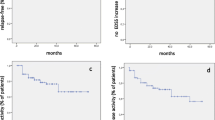Abstract
Natalizumab (NAT) is an effective therapy for relapsing–remitting multiple sclerosis (MS), but is associated with an increased risk of progressive multifocal leucoencephalopathy after 2 years therapy. Thus, NAT treated patients often decide to stop NAT therapy after 2 years. Reports on recurrence of disease activity after NAT discontinuation are controversial. We studied disease activity in 13 MS patients who stopped NAT therapy and either remained without disease modifying therapy (no DMT, n = 6), or switched to glatiramer acetate (GLAT, n = 7). Annual relapse rate (ARR), expanded disability status scale (EDSS), and number of patients with contrast-enhancing-lesions (Gd+) on MRI before, during and within 1 year after NAT were determined. We observed recurrence of disease activity in both groups (5/7 GLAT treated patients and 6/6 patients without DMT) within 12 months after cessation of NAT (mean time to first relapse was 5.5 months for all patients). One of the GLAT treated patients and three patients without DMT had severe relapses with sustained EDSS worsening. No differences in ARR, EDSS and MRI parameters were seen between both groups. Patients with relapses after NAT therapy, however, tended to show higher disease activity (EDSS, ARR) before initiation of NAT therapy compared to patients without relapses. Duration of NAT treatment was not associated with higher disease activity after NAT discontinuation. In this observation the majority of patients showed reappearance of disease activity after discontinuation of NAT regardless of whether they switched to GLAT or remained without DMT. Further treatment strategies are warranted for patients who discontinue NAT therapy.



Similar content being viewed by others
References
Polman CH, O’Connor PW, Havrdova E, Hutchinson M, Kappos L, Miller DH, Phillips JT, Lublin FD, Giovannoni G, Wajgt A, Toal M, Lynn F, Panzara MA, Sandrock AW (2006) A randomized, placebo-controlled trial of natalizumab for relapsing multiple sclerosis. N Engl J Med 354(9):899–910
Rudick RA, Stuart WH, Calabresi PA, Confavreux C, Galetta SL, Radue EW, Lublin FD, Weinstock-Guttman B, Wynn DR, Lynn F, Panzara MA, Sandrock AW (2006) Natalizumab plus interferon beta-1a for relapsing multiple sclerosis. N Engl J Med 354(9):911–923
Langer-Gould A, Atlas SW, Green AJ, Bollen AW, Pelletier D (2005) Progressive multifocal leukoencephalopathy in a patient treated with natalizumab. N Engl J Med 353(4):375–381
Linda H, von Heijne A, Major EO, Ryschkewitsch C, Berg J, Olsson T, Martin C (2009) Progressive multifocal leukoencephalopathy after natalizumab monotherapy. N Engl J Med 361(11):1081–1087
Stuve O, Marra CM, Jerome KR, Cook L, Cravens PD, Cepok S, Frohman EM, Phillips JT, Arendt G, Hemmer B, Monson NL, Racke MK (2006) Immune surveillance in multiple sclerosis patients treated with natalizumab. Ann Neurol 59(5):743–747
Vellinga MM, Castelijns JA, Barkhof F, Uitdehaag BM, Polman CH (2008) Postwithdrawal rebound increase in T2 lesional activity in natalizumab-treated MS patients. Neurology 70 (13 Pt 2):1150–1151
Killestein J, Vennegoor A, Strijbis EM, Seewann A, van Oosten BW, Uitdehaag BM, Polman CH (2010) Natalizumab drug holiday in multiple sclerosis: poorly tolerated. Ann Neurol 68(3):392–395
Lenhard T, Biller A, Mueller W, Metz I, Schonberger J, Wildemann B (2010) Immune reconstitution inflammatory syndrome after withdrawal of natalizumab? Neurology 75(9):831–833
Miravalle A, Jensen R, Kinkel RP (2011) Immune reconstitution inflammatory syndrome in patients with multiple sclerosis following cessation of natalizumab therapy. Arch Neurol 68(2):186–191
Goodman AD, Rossman H, Bar-Or A, Miller A, Miller DH, Schmierer K, Lublin F, Khan O, Bormann NM, Yang M, Panzara MA, Sandrock AW (2009) GLANCE: results of a phase 2, randomized, double-blind, placebo-controlled study. Neurology 72(9):806–812
Stuve O, Cravens PD, Frohman EM, Phillips JT, Remington GM, von Geldern G, Cepok S, Singh MP, Cohen Tervaert JW, De Baets M, MacManus D, Miller DH, Radu EW, Cameron EM, Monson NL, Zhang S, Kim R, Hemmer B, Racke MK (2009) Immunologic, clinical, and radiologic status 14 months after cessation of natalizumab therapy. Neurology 72(5):396–401
Stuve O, Marra CM, Bar-Or A, Niino M, Cravens PD, Cepok S, Frohman EM, Phillips JT, Arendt G, Jerome KR, Cook L, Grand’Maison F, Hemmer B, Monson NL, Racke MK (2006) Altered CD4+/CD8+ T-cell ratios in cerebrospinal fluid of natalizumab-treated patients with multiple sclerosis. Arch Neurol 63(10):1383–1387
Acknowledgments
Sabine Pitter, Heike Staufer and H. Sahm-Traore provided excellent technical assistance. The authors thank Drs. M. Kerschensteiner and E. Meinl for helpful comments on the manuscript.
Conflict of interest
R.H. is supported by the Deutsche Forschungsgemeinschaft (SFB 571, A1) and has received personal compensations from Bayer Schering Pharmacy, Teva, Merck-Serono, Biogen-Idec, and Novartis. T.K. has received personal compensations from Bayer Schering Pharmacy, Teva, Merck-Serono, and Biogen-Idec, grant support from Bayer-Schering AG. F.W. has received personal compensations from Bayer-Schering AG, Biogen Idec, Orion Pharma, Pfizer-Pharma, Merck-Serono, grant support from Bayer-Schering AG, Merck-Serono and TEVA Pharma GmbH. H.P., L.G. and J.H. have received personal compensations from Merck-Serono, Teva, Bayer-Schering, Novartis, Merz Pharma and Biogen-Idec. H.F. has received personal compensations from Merck-Serono, Teva, Novartis and Biogen-Idec. I.M. has received personal compensations from Bayer-Schering. The other authors report no disclosures.
Author information
Authors and Affiliations
Corresponding author
Rights and permissions
About this article
Cite this article
Havla, J., Gerdes, L.A., Meinl, I. et al. De-escalation from natalizumab in multiple sclerosis: recurrence of disease activity despite switching to glatiramer acetate. J Neurol 258, 1665–1669 (2011). https://doi.org/10.1007/s00415-011-5996-y
Received:
Revised:
Accepted:
Published:
Issue Date:
DOI: https://doi.org/10.1007/s00415-011-5996-y




